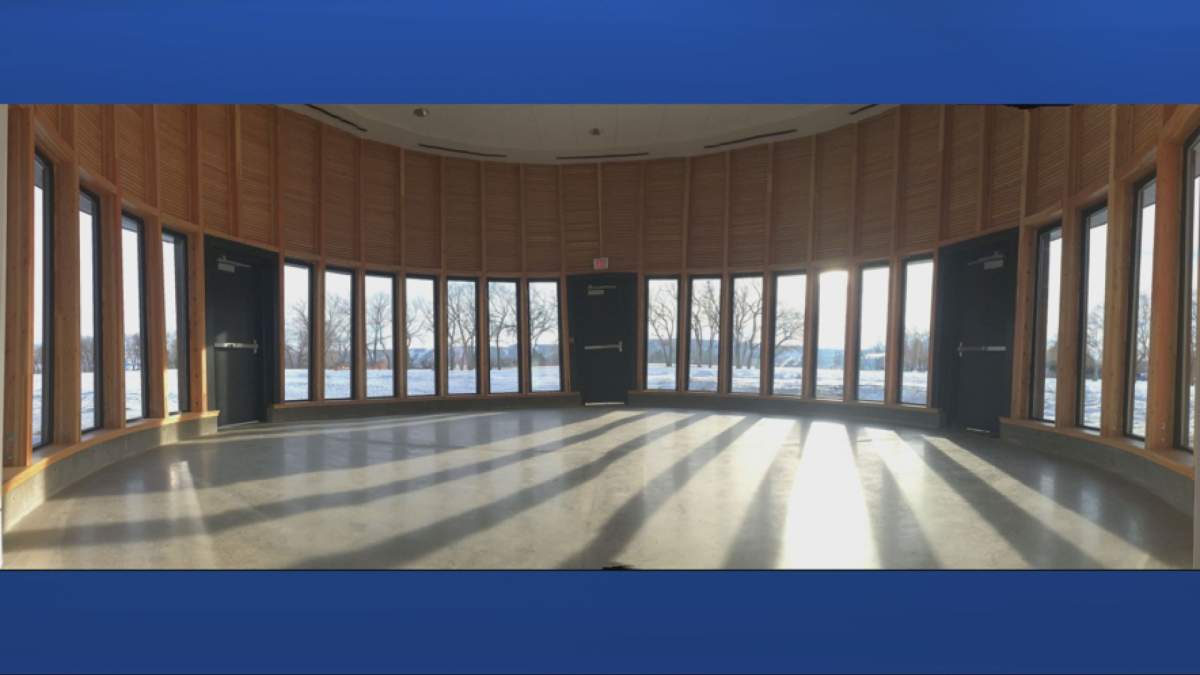Students and staff at Bert Fox Community High School in Fort Qu’Appelle, along with community members, now have a ceremonial room in which to hold circle and practise other Indigenous ceremonies and traditions.

Before the room was built, students were using an old classroom for the same purpose. Knowledge Carrier with the school, Philip Brass, said school officials and community members wanted something more culturally appropriate for them.
Brass is excited to see the design come to life.
“I had just sort of scribbled it down on a piece of paper at a meeting and then we began meeting with architects and basically they built what I drew, which is an honour to have been able to contribute in that way,” he said.
The ceremonial space is located at the back of the school, though Brass said the original idea was to feature it as a main element at the front of the school foyer.
“We thought about the realities of what the space will be used for and we knew ceremony would be a part of that,” Brass said.
He explained his idea to have the space conducive to ceremony with access to doors on the outside of the building. To include south facing doors, the room had to be situated at the back of the school.
Brass explained the demographic of Bert Fox is about 70 per cent Indigenous students from several different communities that represent different linguistic nations. There are Dakota youth from Standing Buffalo, Saulteux youth from Pasqua and Muscowpetung, a few students who are Nehiyaw from Star Blanket, and some students who are Nakoda from Carry the Kettle, he said.

Get daily National news
Brass said stakeholders and those involved with the planning wanted a space that could be utilized by elders of various nations.
During planning sessions, Brass said he wanted to see a space that was focused on functionality rather than optics.
“I said this doesn’t necessarily have to be something to show off as optics of culture, that we really just need functionality and sometimes you need privacy,” Brass said. Students and staff need to walk through a back hallway to access the room from inside the school.
“But really, that was about getting it positioned on the south side of the school. That was what was important, because we needed south-facing doors that opened to the outside,” Brass said.
The ceremonial room is attached to a classroom that has been converted to a land-based education room with a floor-to-ceiling whiteboard.
Right now, Brass is working with students on animal hides, such as moose, buffalo, caribou, and bear hides.

Another example of a land-based learning activity is fishing trips, where students set nets, bring fish back to the classroom, and learn how to fillet different species.
Bert Fox principal Julie Stiglitz said that building the ceremonial room is part of the Truth and Reconciliation Calls to Action and “is part of being a good treaty neighbour.”
Stiglitz told Global News on Thursday the school had a pipe ceremony in the space.
“It gives students a real sense that their identity is valued at school and that for treaty relationship that we walk this together and that there’s space in the school that’s specifically Indigenous,” she said.
Because the room has doors on the exterior, community members can access the space after school hours.
The ceremonial room will also be used to hold circle to support students.
“The student isn’t our student, the student is part of community. They’re their child, their parent’s child. We look holistically at the student and try to support them in any way we can. Not just through their school, but through their community through the larger support systems,” Stiglitz said.
Stiglitz said consultation about the design started in November 2019 and stakeholders, elders and knowledge carriers from the community were involved.
The space is multi-purpose, meaning teachers may have a full class using it for land-based learning, or it may be used by the community for ceremonial purposes. Students can also smudge in the room at any time, in addition to other spaces within the school.
Brass explained that the new ceremonial room is about recognizing the shifting demographic at the high school from non-Indigenous students to now 70 per cent Indigenous students.
“Those indigenous kids have educational needs that are different than in the past. We need, not only in that physical building, a culture room. It’s really about shifting the culture of the school and teaching in our curriculum to reflect the needs of Indigenous youth.”
Brass added that the ceremonial space is also available to community members as well as non-Indigenous students. He said it’s important to provide education to non-Indigenous students so they learn the history of the area, which Brass said was the centre of where Treaty 4 was signed.








Comments